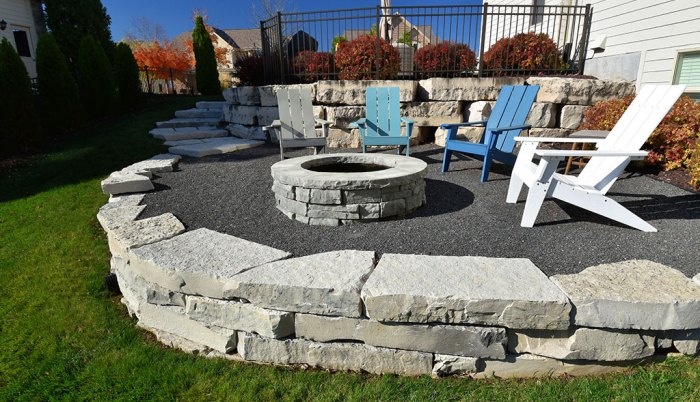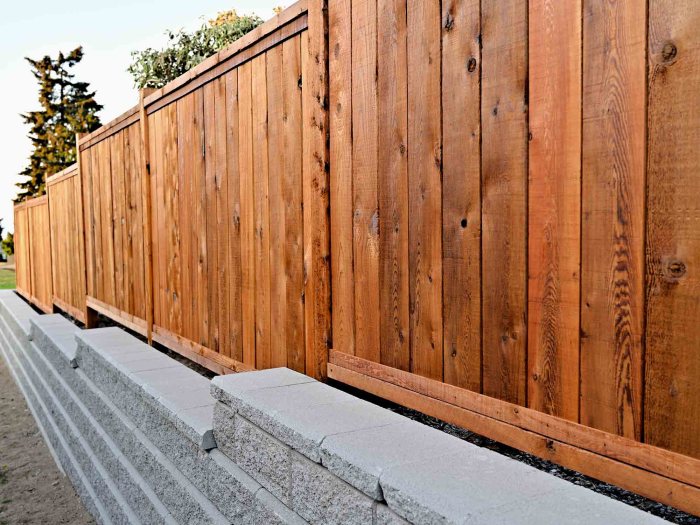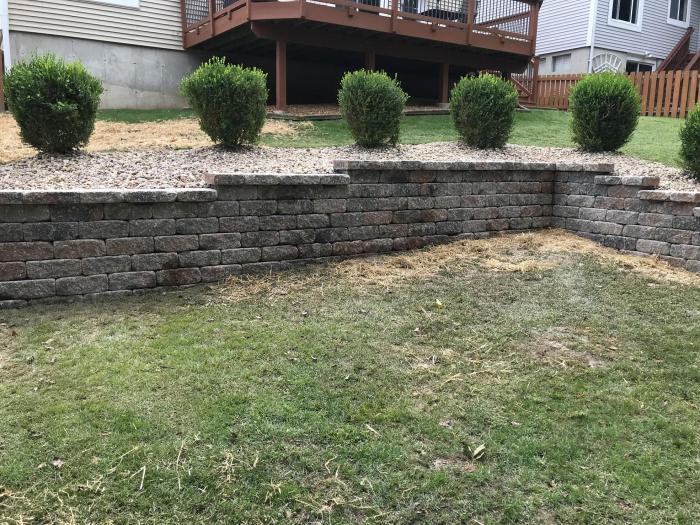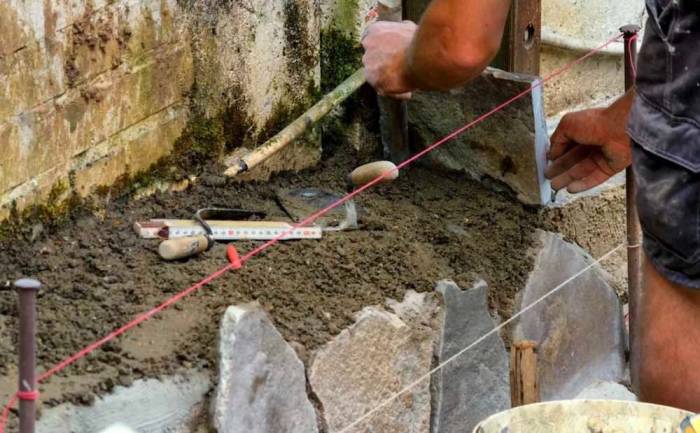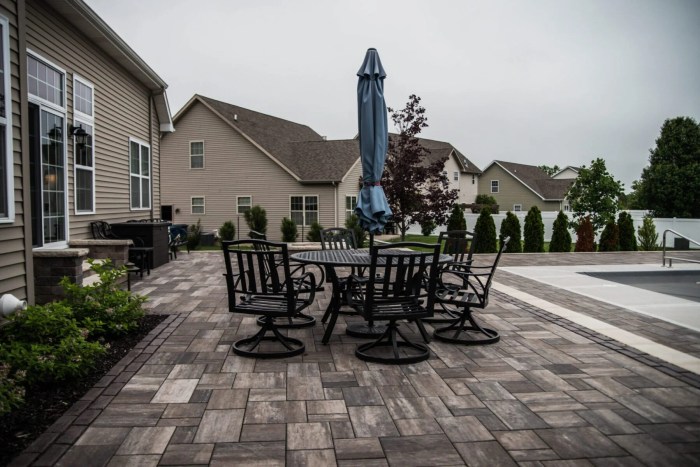Arbor Rock and Wall Landscaping Design & Installation
Arbor rock and wall landscaping offers a unique way to enhance outdoor spaces. From historical precedents to modern interpretations, this approach blends natural elements with careful design to create visually stunning and functional landscapes. Different materials, wall types, and rock formations allow for a wide array of styles and aesthetics. This exploration will cover everything from design considerations and installation methods to maintenance and environmental impact, ensuring a comprehensive understanding of this captivating landscaping technique.
This guide delves into the art and science of creating stunning landscapes using strategically placed rocks and walls. We’ll examine the crucial steps involved, from site analysis to final installation, to ensure long-term success and beauty. Understanding the nuances of material selection, design principles, and maintenance practices will enable you to create your own unique arbor rock and wall masterpiece.
Introduction to Arbor Rock and Wall Landscaping
Arbor rock and wall landscaping is a design approach that integrates natural rock formations and walls into garden and outdoor spaces. This style aims to create a visually appealing and functional environment that seamlessly blends natural elements with human-made structures. The design approach emphasizes texture, color, and form to achieve a sense of tranquility and aesthetic appeal.
This landscaping style has evolved from a simple practice of utilizing rocks for retaining walls to a sophisticated art form that incorporates various design elements and materials. The use of rocks and walls for landscaping is not a new concept, but its application and sophistication have evolved, responding to changing aesthetic preferences and technological advancements.
Historical Context and Evolution
Arbor rock and wall landscaping has ancient roots. Early civilizations used rocks for building walls, creating terraces, and defining boundaries. The practice of using rocks for aesthetic purposes in gardens evolved over centuries. Modern approaches draw inspiration from these historical precedents while incorporating contemporary design elements. Different cultures and periods have contributed to the development of various styles, including Japanese rock gardens and the use of dry-laid stone walls in European gardens.
Materials Commonly Used
Various materials are used in arbor rock and wall landscaping. Natural stone, such as granite, limestone, sandstone, and slate, is commonly employed. These materials offer a wide range of colors, textures, and forms. Additionally, manufactured materials, like concrete and poured walls, can also be used for certain applications. The choice of material depends on factors such as budget, desired aesthetic, and the specific project requirements. Each material brings unique visual characteristics and durability to the design.
Types of Walls and Rock Formations
A wide array of wall and rock formations is used. Retaining walls, dry-laid stone walls, and stacked stone walls are popular choices. These structures can be designed to support slopes, create tiered garden levels, and define different areas within the landscape. Natural rock formations, like boulders and outcrops, can also be incorporated into the design, creating a sense of natural integration. The design choices are influenced by the terrain, the desired aesthetic, and the specific functions of the walls and rock formations.
Popular Design Elements
Common design elements in arbor rock and wall landscaping include the use of varying rock sizes and textures. Landscaping designers often incorporate pathways made of stone or gravel, creating a natural and inviting flow throughout the space. Plants, carefully chosen for their compatibility with the rocks and walls, are integral to the design. The combination of elements like water features, lighting, and seating areas further enhances the overall aesthetic. This combination creates a cohesive and visually stimulating landscape.
Rock Types and Suitability for Wall Landscaping
| Rock Type | Suitability for Wall Landscaping | Notes |
|---|---|---|
| Granite | Excellent | Durable, resistant to weathering, and come in various colors and textures. |
| Limestone | Good | Relatively easy to work with, available in a range of colors. |
| Sandstone | Moderate | Can be susceptible to erosion, requires careful selection, and maintenance. |
| Slate | Good | Durable, often used for roofing and walls, creates a unique texture. |
| Boulders | Excellent (for accent/features) | Large rocks, used for focal points or natural features. |
The suitability of a rock type depends on the specific design requirements and the environmental conditions. Careful consideration of the rock’s durability, weight, and appearance is crucial in ensuring the long-term stability and visual appeal of the landscape design.
Design Considerations for Arbor Rock and Wall Landscapes
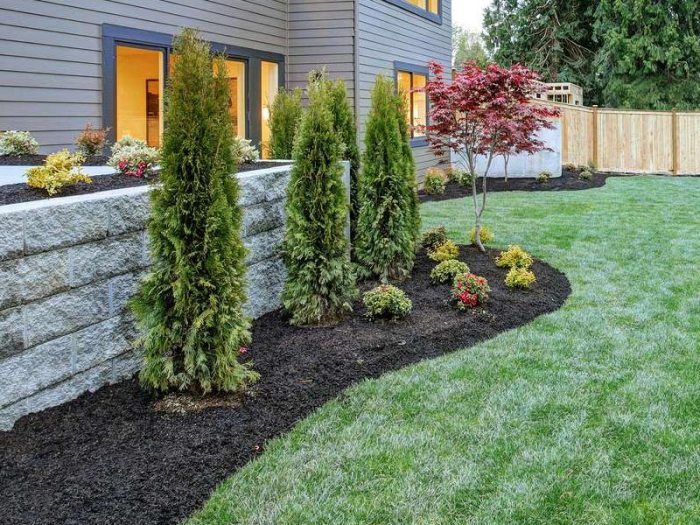
Source: ncgreenscapes.com
Arbor rock and wall landscaping offers a unique opportunity to create visually striking and functional outdoor spaces. Careful consideration of design elements is crucial to achieving a harmonious blend of aesthetics and practicality. This involves understanding the site’s characteristics, integrating with existing structures, and thoughtfully selecting plants and materials.
Effective arbor rock and wall landscaping is not simply about arranging rocks and walls; it’s about creating a cohesive and engaging outdoor environment that reflects the homeowner’s style and complements the surrounding landscape. This requires a comprehensive understanding of the site’s unique features, the principles of visual appeal, and the integration of the design with existing structures. Proper plant selection is paramount for thriving and visually compelling results, and selecting the right rock textures can greatly enhance the overall aesthetic appeal. Understanding different design styles allows for a tailored and cohesive approach.
Site Analysis in Arbor Rock and Wall Design
Thorough site analysis is fundamental to the success of any arbor rock and wall project. This involves evaluating the topography, soil conditions, sunlight exposure, and existing vegetation. Understanding the natural contours of the land is crucial for creating a landscape that feels integrated and natural. Analyzing soil type, drainage patterns, and water sources will inform material choices and planting strategies. Identifying areas of sunlight and shade will help determine appropriate plant selection. Existing vegetation should be considered to maintain a harmonious balance and avoid unnecessary disruption. Ultimately, a thorough site analysis allows for the creation of a landscape that is both visually appealing and sustainable.
Principles of Visually Appealing and Functional Landscape Design
Creating a visually appealing and functional landscape requires adherence to fundamental principles. Balance and proportion are crucial; elements should be arranged in a way that creates visual harmony and avoids monotony. Unity and rhythm, achieved through repetition and variation of design elements, contribute to a cohesive and aesthetically pleasing effect. Consideration of scale is essential for maintaining a sense of proportion and visual impact. The careful placement of hardscape features, like walls and walkways, and the selection of appropriate plants can significantly enhance the landscape’s functionality and beauty.
Integrating Design with Existing Structures
Integrating the design with existing structures is vital for creating a seamless and cohesive landscape. Existing architectural styles, materials, and colors should be considered during the design process. The aim is to create a landscape that complements the architecture rather than clashing with it. Existing pathways, patios, and other hardscapes should be incorporated thoughtfully to enhance the flow and usability of the space. Careful consideration should be given to how the landscaping will interact with the existing structures, minimizing potential conflicts and maximizing the overall aesthetic impact.
Plant Selection in Conjunction with Rock and Wall Features
Plant selection is integral to successful arbor rock and wall landscaping. Plants should be chosen for their visual appeal, hardiness, and ability to thrive in the specific conditions of the site. Consideration should be given to the size, shape, and color of plants about the rock and wall features. Plant height and spread must be evaluated to avoid overshadowing or disrupting the visual balance of the landscape. The selection of plants that complement the color palette of the rocks and walls is crucial for achieving a unified aesthetic.
Comparison of Design Styles in Arbor Rock and Wall Landscaping
Different design styles in arbor rock and wall landscaping offer diverse options. Contemporary designs often emphasize clean lines, geometric shapes, and a minimalist aesthetic. Traditional designs frequently incorporate natural materials, organic shapes, and a sense of history. Transitional styles blend elements of both contemporary and traditional aesthetics, creating a balance between modern functionality and traditional charm. Rustic designs incorporate natural elements, showcasing the raw beauty of rocks, wood, and natural textures. The choice of style should reflect the homeowner’s preferences and the overall character of the property.
Comparison of Rock Textures and Visual Impact
| Rock Texture | Visual Impact | Examples |
|---|---|---|
| Smooth, polished | Creates a sleek, modern look. Often associated with minimalist or contemporary designs. | Granite, polished limestone |
| Rough, textured | Adds a rustic, natural element to the landscape. Suitable for traditional or natural styles. | Fieldstone, tumbled river rock |
| Layered, striated | Creates a visually interesting depth and pattern. Works well in both contemporary and traditional designs. | Slate, flagstone |
| Bumpy, irregular | Provides a dynamic and engaging visual element, often used in natural or rustic styles. | Boulder, quartzite |
Different rock textures offer varying visual impacts. Smooth rocks create a sleek, modern aesthetic, while rough textures lend a rustic, natural feel. Layered or striated rocks add visual depth, and bumpy rocks provide a dynamic element. Choosing the right texture will significantly influence the overall aesthetic of the arbor rock and wall landscape.
Practical Application and Installation
Planning and executing an arbor rock and wall landscaping project requires meticulous attention to detail. Careful site preparation, appropriate construction techniques, and thoughtful integration of plants are critical for long-term success. The durability and aesthetic appeal of the finished project hinge on these crucial steps.
Effective installation hinges on understanding the specific needs of the site and the desired outcome. This involves considering the local climate, soil conditions, and the chosen design elements. Prioritizing proper drainage, selecting suitable materials, and employing sound construction techniques are key to preventing future problems and ensuring a beautiful, functional landscape.
Site Planning and Preparation
Careful site preparation is paramount for a successful arbor rock and wall installation. This involves assessing the existing terrain, identifying drainage patterns, and determining the best location for the features. Understanding the soil type is essential for proper foundation preparation. A well-prepared site ensures the longevity and stability of the constructed elements. A professional assessment will help establish the best location and design to meet your needs. Consideration should also be given to the surrounding landscaping, ensuring that the new features complement and enhance the existing aesthetic.
Wall and Rock Feature Construction
Constructing various rock and wall features requires specialized techniques. Retaining walls, dry-stacked walls, and decorative rock features each have unique construction methods. Proper use of tools and techniques is essential for achieving stability and a pleasing aesthetic. Dry-stacked walls, for example, rely on the interlocking nature of the stones, and precise placement is critical for preventing shifts and cracks. Understanding the different types of stone, their weight-bearing capacities, and their inherent properties will allow you to choose materials and methods that meet the specific needs of the project.
Securing and Stabilizing Elements
Ensuring the stability of rock and wall elements is crucial. This involves using appropriate anchoring techniques, proper drainage systems, and geotextile fabrics. Appropriate anchoring methods are crucial for preventing slippage and maintaining the integrity of the structure. Using geotextile fabrics underneath the stonework helps prevent soil erosion and promotes better drainage. Proper drainage is critical to prevent water buildup and potential structural damage.
Incorporating Plants and Other Features
Integrating plants and other landscaping elements is vital for creating a cohesive and visually appealing landscape. Choosing appropriate plant species, considering their growth habits, and ensuring proper spacing are important. The selection of plants should complement the rock and wall features and enhance the overall aesthetic appeal. Careful consideration should be given to the mature size of the plants to prevent overcrowding and maintain the desired aesthetic balance.
Installation of a Retaining Wall (using Rock)
| Step | Description |
|---|---|
| 1 | Survey the site, mark the wall boundaries, and excavate the area according to design specifications. |
| 2 | Install drainage and geotextile fabric for proper water management and erosion control. |
| 3 | Lay a compacted gravel base and a leveling layer of compacted soil. |
| 4 | Construct the wall using selected rock, ensuring proper interlocking and stability. |
| 5 | Secure the wall with appropriate anchoring systems. |
| 6 | Backfill with soil, and grade around the wall. |
| 7 | Plant vegetation according to plan. |
Challenges and Solutions in Different Climates
Different climates present unique challenges for arbor rock and wall installations. In arid regions, water conservation is key, and drought-tolerant plants are necessary. In humid climates, proper drainage is essential to prevent water damage and fungal growth. In regions with significant temperature fluctuations, the choice of materials should consider expansion and contraction. Understanding these challenges and selecting appropriate materials and techniques will ensure the long-term success of the project. For instance, using appropriate waterproof sealants in humid areas or choosing heat-resistant materials in regions with significant temperature changes will ensure the project’s longevity.
Maintenance and Longevity of Arbor Rock and Wall Landscapes
Proper maintenance is crucial for preserving the aesthetic appeal and longevity of arbor rock and wall landscapes. Regular upkeep ensures that these features remain visually stunning and structurally sound for years to come. Ignoring maintenance can lead to costly repairs and a significant reduction in the overall lifespan of the design.
Maintaining the integrity of arbor rock and wall landscapes requires a proactive approach. Consistent attention to detail and a well-defined maintenance schedule are essential for preventing issues like erosion, moss growth, and plant encroachment. This proactive approach not only preserves the beauty of the landscape but also prevents potential safety hazards associated with decaying structures.
Importance of Regular Maintenance
Regular maintenance is vital for the long-term health and beauty of arbor rock and wall landscapes. It involves addressing minor issues before they escalate into major problems, ensuring the structural integrity of the walls and the overall aesthetic appeal of the rock features. This proactive approach safeguards the investment in the landscape and prevents costly repairs or replacements in the future. A well-maintained landscape enhances the property value and provides a visually pleasing environment.
Methods for Maintaining Walls and Rock Features
Regular cleaning and inspection are essential. Cleaning the walls and rock surfaces removes debris, moss, and algae, which can compromise the structural integrity and aesthetic appeal. This involves using appropriate cleaning solutions and tools, ensuring the surface is not damaged in the process. Inspection for signs of deterioration, such as cracks, loose stones, or shifting foundations, is also important. Early detection of these issues allows for prompt repairs and prevents further damage.
Preventing Erosion and Weathering
Protecting the rock and wall features from erosion and weathering is crucial. Properly sealing or covering the exposed surfaces of the walls can protect them from rain and harsh weather conditions. Using appropriate materials and techniques can help prevent the build-up of moisture that can lead to deterioration. Implementing drainage systems around the walls and rock features is essential to prevent water pooling, which can contribute to erosion. Careful selection of plants and appropriate spacing can also help to mitigate erosion and weathering.
Addressing Issues Like Moss Growth or Plant Encroachment
Addressing issues like moss growth and plant encroachment requires targeted interventions. Removing moss effectively prevents its spread and maintains the aesthetic appeal of the landscape. This often involves using specialized cleaning solutions or mechanical removal methods, depending on the severity of the issue. Controlling plant encroachment, particularly around the base of walls and rock features, is also essential. This can be achieved through pruning, weeding, and appropriate landscaping practices.
Methods for Repairing or Replacing Damaged Areas
Repairing or replacing damaged areas in the landscape is part of the maintenance process. This involves identifying the source of damage, assessing the extent of the damage, and implementing appropriate repair techniques. For minor cracks or loose stones, patching or re-securing the affected area can restore the integrity of the structure. For more extensive damage, replacing damaged sections with matching materials is necessary. Proper planning and execution are crucial for successful repairs or replacements, ensuring the structural integrity and aesthetic harmony of the landscape.
Maintenance Schedule
| Feature Type | Frequency of Cleaning | Frequency of Inspection | Frequency of Weed Removal | Frequency of Moss Treatment |
|---|---|---|---|---|
| Dry-laid stone walls | Quarterly | Monthly | Bi-weekly | As needed |
| Mortar-laid stone walls | Semi-annually | Quarterly | Bi-weekly | As needed |
| Arbor rock features | Semi-annually | Monthly | Bi-weekly | As needed |
| Planted rock walls | Quarterly | Monthly | Weekly | As needed |
This table provides a general maintenance schedule. Specific needs may vary based on factors such as climate, local vegetation, and the materials used in construction. Adjusting the schedule based on these specific factors is crucial for optimal maintenance.
Environmental Considerations and Sustainability
Arbor rock and wall landscaping, while aesthetically pleasing, can have a significant environmental impact. Careful consideration of materials, water usage, and plant choices is crucial for creating a sustainable design. This section explores ways to minimize negative environmental consequences and maximize the ecological benefits of this landscaping approach.
Sustainable landscaping practices are increasingly important for mitigating climate change and preserving natural resources. By incorporating eco-friendly materials and native vegetation, arbor rock and wall designs can contribute positively to the surrounding ecosystem.
Environmental Impact of Arbor Rock and Wall Landscaping
The environmental impact of arbor rock and wall landscaping varies depending on the materials used, the design choices, and the region’s climate. Factors such as water consumption, soil erosion, and the use of non-renewable resources need careful consideration. The construction of rock walls, for example, can have an impact on local ecosystems, although the effect is often mitigated with thoughtful planning.
Sustainable Materials in Arbor Rock and Wall Landscapes
Using sustainable materials is key to minimizing the environmental footprint. Recycled or reclaimed materials, such as salvaged stone or repurposed concrete, are excellent choices. These alternatives often have a lower carbon footprint compared to newly extracted materials. Prioritizing locally sourced materials further reduces transportation emissions and supports local economies.
Minimizing Water Consumption and Erosion
Efficient water management is essential for sustainable arbor rock and wall landscapes. Xeriscaping techniques, employing drought-tolerant plants and strategically placed mulch, can significantly reduce irrigation needs. Careful design of drainage systems prevents water runoff and minimizes erosion. Rainwater harvesting can be integrated into the design to collect and reuse water for irrigation.
Eco-Friendly Plants for Arbor Rock and Wall Landscaping
Selecting appropriate plants is vital for a sustainable landscape. Native plants are well-adapted to local conditions and require less water and maintenance than non-native species. Drought-tolerant plants are crucial for minimizing water consumption in arid or semi-arid climates. They thrive with less frequent irrigation, contributing to water conservation. Examples include succulents, cacti, and certain grasses.
Incorporating Native Plants and Vegetation
Native plants and vegetation provide numerous ecological benefits. They support local wildlife by providing food and shelter for insects, birds, and other animals. These plants are naturally adapted to the local climate, soil conditions, and rainfall patterns, reducing the need for fertilizers and pesticides. Native plants also contribute to biodiversity by providing habitat for various species. For example, a mix of native wildflowers can create a vibrant and diverse ecosystem within a rock garden.
Eco-Friendly Materials and Sustainability Ratings
| Material | Sustainability Rating | Description |
|---|---|---|
| Recycled Concrete | High | Reduces reliance on raw materials and lowers carbon emissions. |
| Reclaimed Stone | High | Reduces quarrying and transportation impact. |
| Locally Sourced Stone | Medium | Reduces transportation distances, supports the local economy. |
| Engineered Stone | Medium | Often made from recycled materials, but vary in sustainability based on the manufacturing process. |
| Pressure Treated Wood | Low | Requires careful consideration due to potential chemical leaching. |
Visual Appeal and Aesthetics
Arbor rock and wall landscaping offers a compelling avenue for transforming outdoor spaces into visually engaging and functional environments. Careful consideration of aesthetics, including color, texture, and form, is crucial for achieving a captivating and harmonious design. Integrating these elements allows for the creation of unique and personalized landscapes that reflect the owner’s taste and style.
Stunning Landscape Examples
Arbor rock and wall techniques can be employed to create a variety of stunning landscapes. For instance, a modern minimalist garden might feature clean lines and geometric shapes using stacked stone walls to define distinct zones. A more rustic design could utilize natural stone walls and varying textures to mimic the look of a natural woodland setting. The choice of style depends heavily on the desired aesthetic and the overall character of the property. Landscapes can be tailored to reflect a range of moods and themes, from serene tranquility to vibrant energy.
Creating Depth and Visual Interest
Employing techniques to create depth and visual interest in the landscape is vital for an engaging design. This can be achieved through the strategic use of varying heights and textures. For example, incorporating layered plantings, from low groundcovers to tall shrubs and trees, provides a sense of depth. Similarly, using different rock sizes and shapes, creating tiered rock walls, and strategically placing focal points like water features or sculptures can further enhance the perception of depth and visual intrigue.
Color and Texture Enhancement
Color and texture play pivotal roles in enhancing the overall aesthetic appeal of an arbor, rock, nd wall landscape. Using complementary colors in the planting scheme can create a visually pleasing harmony. For example, deep reds and oranges can complement earthy tones in the rocks and walls, while cool blues and greens provide a tranquil ambiance. A variety of textures, such as rough-hewn stone, smooth river rocks, and different plant foliage, can add visual richness and depth. The contrasting textures can highlight the beauty of the rock and wall elements.
Balance and Proportion
Balance and proportion are fundamental principles in landscape design. A well-balanced landscape design uses symmetry or asymmetry to create a visually harmonious composition. For instance, a symmetrical design with matching elements on either side of a central axis can create a sense of formality, while an asymmetrical design with varied elements creates a more dynamic and informal aesthetic. Proportion considers the relative size and scale of elements in the landscape. Overly large or small elements can disrupt the overall visual balance. Careful consideration of these factors ensures a pleasing and harmonious aesthetic.
Artistic Approaches to Unique Features
Unique and eye-catching features can be developed using various artistic approaches. For instance, the use of natural materials, such as reclaimed wood or weathered stone, can add a rustic touch to a landscape. The use of intricate patterns in the rock walls can add an artistic dimension. Geometric shapes and patterns can be employed to create a modern aesthetic. Furthermore, integrating water features, like small ponds or fountains, can add a touch of serenity and visual interest.
Color Palettes and Their Impact, Arbor rock and wall landscaping
The choice of color palette significantly influences the overall mood and aesthetics of the landscape.
| Color Palette | Impact |
|---|---|
| Earthy Tones (browns, grays, greens) | Creates a natural, serene, and grounded ambiance. |
| Warm Tones (reds, oranges, yellows) | Evokes energy, vibrancy, and a sense of warmth. |
| Cool Tones (blues, greens, purples) | Creates a calming, tranquil, and refreshing atmosphere. |
| Monochromatic Palettes (variations of a single color) | Highlights texture and form, creating a sophisticated and elegant design. |
| Contrasting Colors (high-contrast pairings) | Creates visual interest and dynamism, drawing attention to specific features. |
Project Case Studies and Examples
Real-world arbor rock and wall landscaping projects offer valuable insights into design considerations, challenges, and successful outcomes. These case studies demonstrate the practical application of techniques and highlight the importance of careful planning and execution. Analyzing these projects allows for a deeper understanding of the nuances involved in this specialized field.
Residential Project: The Modern Retreat
This project involved transforming a sloping backyard into a visually appealing and functional outdoor space. Design considerations included mitigating erosion, maximizing usable space, and integrating existing mature trees. The challenge lay in balancing the aesthetic appeal with the practical need for retaining walls to stabilize the slope. The design incorporated a series of tiered rock walls, interspersed with native plantings, to create distinct seating areas and pathways. A water feature, strategically placed, added a tranquil ambiance. The final result was a beautifully landscaped area that harmonized with the surrounding environment, enhancing the property’s value. The project exceeded expectations in terms of both aesthetics and functionality.
Commercial Project: The Urban Oasis
This project focused on creating an inviting outdoor space for a bustling office complex. Design considerations prioritized accessibility, durability, and low-maintenance landscaping. The challenge involved integrating a complex design within a constrained space while ensuring safety for pedestrians and employees. The solution involved a modern, geometric design using stacked stone walls, which formed decorative planters and seating areas. Careful selection of drought-tolerant plants ensured minimal upkeep. The project showcased the versatility of arbor rock and wall landscaping in a high-traffic environment, proving its suitability for commercial spaces. This case study highlights the potential of arbor rock and wall landscaping in enhancing public perception and creating a welcoming atmosphere.
Table: Project Case Studies Summary
| Project Name | Budget (USD) | Timeline (Months) | Primary Materials | Challenges | Outcomes |
|---|---|---|---|---|---|
| The Modern Retreat | $35,000 | 6 | Locally sourced fieldstone, native plants, engineered wood | Slope stabilization, minimizing disruption to existing trees | Increased property value, created a functional and visually appealing outdoor space |
| The Urban Oasis | $70,000 | 8 | Concrete retaining walls, decorative gravel, and drought-tolerant shrubs | Limited space, pedestrian safety concerns, and minimizing maintenance | Enhanced aesthetic appeal, created a welcoming outdoor area, and reduced landscaping costs in the long run |
Key Lessons Learned
Careful site analysis is crucial for determining the most suitable materials and design approach. Effective communication between the design team and the client is vital for a successful project. Budgeting and timeline considerations should be addressed proactively to avoid unforeseen issues. Proper material selection and installation are essential for long-term durability and maintenance. Understanding the local climate and environmental conditions is vital for plant selection and design. These factors will ensure that the landscape will thrive and maintain its visual appeal. Incorporating sustainable practices is critical for minimizing environmental impact.
End of Discussion: Arbor Rock And Wall Landscaping
In conclusion, arbor rock and wall landscaping provides a compelling blend of aesthetics and functionality. By carefully considering design elements, installation techniques, and long-term maintenance, homeowners can achieve stunning outdoor spaces that seamlessly integrate natural beauty with architectural precision. From historical influences to sustainable practices, this guide has explored the multifaceted nature of this captivating landscaping style. We hope this comprehensive overview inspires you to embark on your own arbor rock and wall landscaping project, transforming your outdoor environment into a true work of art.
